This week, we're taking on your science questions. We find out how cockroaches and ants avoid the heat in a microwave oven, how best to protect yourself from lightning and why a light box can save you from a SAD winter. Also, a table decoration inspired, radiation-resistant spaceship design to keep astronauts healthy, how the contraceptive pill hurts A lapdancers' looks and why penguins prefer to go fishing with their pals. Plus, in Kitchen Science, Dave explains how to make a detector for the Earth's magnetic field - a home made compass! But will it work in space? And what will happen when the Earth's magnetic field swaps round? We answer all these questions and more.
In this episode
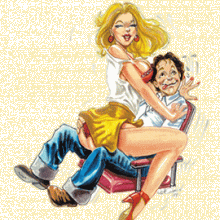
Pill bad for Lapdancers' fortunes
A new study by researchers at the University of New Mexico at Albuquerque and published in this month's Evolution and Human Behaviour shows that female lapdancers seeking to supersize their earnings should eschew use of the oral contraceptive pill, because it makes them less attractive to tipping punters.
 Geoffrey Miller and his colleagues recruited 18 lapdancers from local clubs and asked them to record their menstrual activity, earnings and contraceptive pill use over a 60 day period. The results were striking: the earnings of normally-cycling (non pill-using) women peaked in line with their fertility, exceeding $350 per shift by mid cycle. But their contraceptively-compromised (pill using) counterparts fared less well, earning an average of only $200 in tips per shift throughout their cycles. Significantly, both groups earned approximately the same amount during menstruation, indicating that the effect was not due to an overall difference in attractiveness between the women.
Geoffrey Miller and his colleagues recruited 18 lapdancers from local clubs and asked them to record their menstrual activity, earnings and contraceptive pill use over a 60 day period. The results were striking: the earnings of normally-cycling (non pill-using) women peaked in line with their fertility, exceeding $350 per shift by mid cycle. But their contraceptively-compromised (pill using) counterparts fared less well, earning an average of only $200 in tips per shift throughout their cycles. Significantly, both groups earned approximately the same amount during menstruation, indicating that the effect was not due to an overall difference in attractiveness between the women.
The results strongly argue for the existence of a female "oestrus", which prevailing wisdom claimed had been lost amongst humans during evolution. Instead the results suggest that men can subconsciously detect when women are at their most fertile and tend to judge them as more attractive, valuable and, it would seem, worthy of larger tips at this time! So as well as health consequences, there may be an economic disadvantage to taking the pill too!
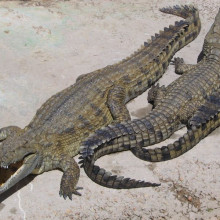
Crocs Cry Real Tears
There's an old myth that crocodiles cry in fake remorse while devouring a meal, which is why we say someone is "crying crocodile tears" when they insincerely turn on the waterworks.
But it turns out that crocs really do weep when they are eating, but surely not because they are feeling emotional.
 Normally, it's rather tricky to work out whether crocodiles are crying when they eat because they spend so much of their time in water and are such feisty creatures they are difficult to train to eat on land. So instead of looking at crocodiles, scientists from the University of Florida decided to try and work out once and for all whether these scaly reptiles do indeed cry while eating, by watching four caimans and three alligators - the slightly less formidable close relatives of crocodiles - which were trained to feed on dry land at a zoo in Florida.
Normally, it's rather tricky to work out whether crocodiles are crying when they eat because they spend so much of their time in water and are such feisty creatures they are difficult to train to eat on land. So instead of looking at crocodiles, scientists from the University of Florida decided to try and work out once and for all whether these scaly reptiles do indeed cry while eating, by watching four caimans and three alligators - the slightly less formidable close relatives of crocodiles - which were trained to feed on dry land at a zoo in Florida.
And the researchers saw that the most of the caiman and alligators did cry while tucking into a meal, some of them even bubbled and frothed from their eyes, confirming what until now had just been anecdotal reports of weeping diners.
There are a couple of possible explanations for the tears shed by the caimans and alligators while they were eating; it could be linked to the hissing and huffing behaviour that often accompanies feeding - by forcing air through their sinuses crocs might stimulate the production of fluid in the lacrimal glands or tear glands; it's also possible that the mechanical action of biting down on their food might cause the jaw muscles to squeeze tears out of the tear glands.
And like human tears, croc tears are likely to be a way of protecting the eyes. While the crocs are feeding there is a lot of activity around the head, when they are subduing their prey, and tears as well as pulling their eyes deeper into their sockets, might help protect them from getting damaged.
And a rather interesting thing is that the idea for this study came partly from a condition in humans known as crocodile tears, in which people cry when they eat. The scientists wanted to get to the bottom of whether crocodiles really do shed tears, and it seems they do.

Particle Physicists Help Fight Fires
Particle Physicists may help foresters by finding fires for them.
This year, forest fires have been particularly in the news with fires in Greece killing at least 64 people and doing nearly a billion pounds worth of damage. Once the fire has got hold it is almost impossible to fight it - the trick is to catch it before it gets to this stage.
 Sattelites can detect fires larger than 30 acres and by looking at the smoke you can find smaller fires, as long as it isn't too windy. Still, this is already too late.
Sattelites can detect fires larger than 30 acres and by looking at the smoke you can find smaller fires, as long as it isn't too windy. Still, this is already too late.
Vladamir Peskov and Antonio Zirhichi have been developing Ultra-violet sensors fot the Large Hadron Collider at CERN, to detect light given off by particles coming out of particle collisons. These detectors are 100 times more sensitive than anything else available, and because flames give off UV light they can detect a flame from 25 meters away and will respond in a few microseconds - it could also be used to detect sparks in oil installations.
They are suggesting mounting their detectors on towers to give firefighters better warning of fires before they become unmanageable.
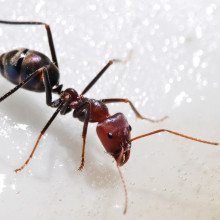
Ant use-by date
New research published in this month's Animal Behaviour reveals that ants seem to be able to predict their own best before dates.
 Dawid Moron from Jagiellonian University in Poland artifically aged European Myrmica scabrinodis ants by exposing them to CO2, which damages the nervous system, or by giving them small injuries to make them vulnerable to infection and dehydration. Over the following five weeks the team then followed up how the injured ants fared against their uninjured nest-mates, and what roles they fulfilled in their colonies. Intriguingly, compared with uninjured ants of a similar age, the compromised individuals tended to take on higher risk tasks, such as foraging outside the nest, at a much younger age than normal. And the more severe their injuries, the sooner they took on these tasks. Such roles are usually assigned only to much older ants, which are deemed more expendable because they are closer to the ends of their lives. They are also more likely to carry parasites and other infections that might pose a threat to the colony, so it makes sense for them to spend more time outside the nest, compared with more valuable younger healthier specimens, that are confined to barracks initially.
Dawid Moron from Jagiellonian University in Poland artifically aged European Myrmica scabrinodis ants by exposing them to CO2, which damages the nervous system, or by giving them small injuries to make them vulnerable to infection and dehydration. Over the following five weeks the team then followed up how the injured ants fared against their uninjured nest-mates, and what roles they fulfilled in their colonies. Intriguingly, compared with uninjured ants of a similar age, the compromised individuals tended to take on higher risk tasks, such as foraging outside the nest, at a much younger age than normal. And the more severe their injuries, the sooner they took on these tasks. Such roles are usually assigned only to much older ants, which are deemed more expendable because they are closer to the ends of their lives. They are also more likely to carry parasites and other infections that might pose a threat to the colony, so it makes sense for them to spend more time outside the nest, compared with more valuable younger healthier specimens, that are confined to barracks initially.
These new findings shed light on how this pecking order might be achieved, which is at least partly due to ants having a strong grasp of their own mortality, and even their "time to live"!
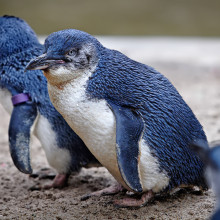
Penguins pick their favourite fishing palls
Picture the scene. You're sitting on a beach on the south coast of Australia, with your eyes and nose filled with the sounds and smells of waves crashing in the distance. But you're not alone, and a gaggle of fairy penguins come hopping and waddling past you, as they make their way down to the sea to go feeding for the day.
 These are the smallest of the worlds penguins, standing just over one foot tall, and instead of dashing down the beach in one big group, the penguins break up into smaller gangs of five to ten, to help avoid being snapped up by predators.
These are the smallest of the worlds penguins, standing just over one foot tall, and instead of dashing down the beach in one big group, the penguins break up into smaller gangs of five to ten, to help avoid being snapped up by predators.
This was the scene that a team of researchers saw at Philip Island Nature Park, in Victoria Australia, and it got them wondering whether the birds form these groups randomly or whether penguins selectively choose particular fishing buddies, a bit like kids picking teams in the school playground for a game of football.
The scientists monitored the movements of individual penguins for four years using an Automated Penguin Monitoring System, which involves placing electronic microchips under their skin.
And they found that penguins do indeed tend to team up with the same penguins to go out fishing, perhaps because it helps if teams of penguins share the same knowledge of particular fishing sites.
But the penguins didn't always team up into the same groups. In years when food was less abundant and fewer chicks were fledged, penguins tended to abandon their groups and feed on their own, perhaps so they didn't have to share the food they found.
And also younger and older penguins weren't picked to form fishing teams because both groups tend to be less good at fishing.
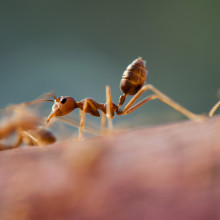
Can ants survive in a microwave?
Someone wrote to us at the Naked Scientists recently who said 'I found a cockroach crawling around in my microwave,' and they said that just for fun they turned on the microwave to zap him. They opened the door 30 seconds later and he was still crawling around.
So it seems some things can survive a dose of microwaves.In a microwave oven the microwaves come out from the right hand side and they bounce off the metal of the far side. It acts like a mirror and it bounces backwards and forwards and they form what's called a standing wave.
You get areas of the microwave which are very, very hot; which have got very, very powerful microwaves and others with approximately nothing at all.
There's about 7.5cm between these hotspots. So you get about four or five hotspots in your microwave, depending on how big it is. If an ant were in a hotspot it would just feel to them like they were in a very, very hot place. So naturally, they'd want to get away from it to somewhere cooler. They would just walk to somewhere cooler where they'll feel a lot more comfortable: just sit there and be fine!
It would be more interesting if there's a turntable because it's there to move the food through the hotspots all the time. The ants would have to keep walking round the turntable to avoid getting cooked.
So it's not a myth after all. There was somebody who made their way into the newspapers for all the wrong reason and they didn't survive, actually. They decided, in a rush to go out on a date, that they would put their head in the microwave to dry their hair quickly. Unfortunately they didn't survive the experience but their hair looked great afterwards!
What should I do when cycling in a thunderstorm?
The way a car protects you from a lightning strike is not because the tyres are insulating so the lightning can't go through it. It's because you're surrounded by the steel body of the car which conducts electricity much better than you do. If lightning hits the car the current is going to want to go through the steel much more than it's going to want to go through you, so the current just goes around you and you're absolutely fine in the middle. This effect is called a Faraday Cage. If you're sitting on a bike and you're not surrounded by metal then the bike will probably make it worse because it will produce a very nice conductive path from your head, through your arms, through the bike and down to the ground very easily. Rubber is an insulator, but even though the tyres are rubber, They're only about 1 inch across and this means the voltage needed to put a spark across that isn't very large. The spark has already jumped about 500m from the clouds to you through the sky. Another inch to the ground isn't going to be too much of a problem.

Why do cooked plums taste so bitter?
We couldn't answer this on the show last time, so we asked you to help. This answer came from Colleen in Michigan...
Colleen suspects it's to do with the breakdown of sugars that give that bitter taste. When you're cooking the sugars at high heat you get non-enzymatic browning, which occurs either through caramelisation or something called the Maillard reaction. That is an interaction of proteins and sugars. A free amino group of a protein reacts with a carbon-R group of a sugar, producing something called N-glycosylamine. This is unstable and is basically a downstream product. It breaks down into something called the melanoidins, which can be bitter to taste. The reactions are pretty complex, she says, and not well understood. So there could be lots of different reasons. That might be why cooking, she says, is so much of an art!

21:23 - Great Trainers or Cash Drainers?
Great Trainers or Cash Drainers?
with Professor Rami Abboud, Ninewells Hospital and Medical School at the University of Dundee
Chris - Now, there's a very interesting study that's been done this week and to join us to talk about it is Professor Rami Abboud. Hello Rami, how are you?
Rami - Hello!
 Chris - Thank you for joining us. Now, people think that the more you spend on a pair of trainers the better they're going to be for your sporting prowess but you're saying that's not the case?
Chris - Thank you for joining us. Now, people think that the more you spend on a pair of trainers the better they're going to be for your sporting prowess but you're saying that's not the case?
Rami - Well, that's what we've found in a study that we've conducted. This is a part of a bigger study, in fact. The database got published in the British Journal of Sports Medicine from a much smaller part of a study that was started some five years ago. What we've done with this study is we've taken three brands and for each brand we have taken low-, medium- and high-cost running shoes. We've compared these three within the same brand. We've used a system called Pedar® which has electronic insoles with 99 sensors each, capable of measuring the pressure between the trainer and the plantar surface of the foot. Then we compared the outcome between the different price tags of each brand and then across the brand.
What we found was that the medium cost and the low-cost running shoes are as good as the most expensive ones if not better within the categories that we have chosen.
Chris - Now, you chose quite a narrow price-banding, if I may say so. I mean GBP30 for a pair of trainers in my book is quite expensive. I go and buy the tenner variety. So what do you think would happen if you bought the really cheap trainers?
Rami - What we have done is look at the branded names. Now, one thing we have not done is look at the non-branded ones. We looked at the branded ones and have actually covered the price tags from GBP30 to GBP150. But this data that we have published now only covered the GBP40-GBP75 bracket.
Chris - So the bottom line is, don't waste money on some really expensive trainers because there's no benefit to your bones through doing that.
Rami - Well, the effect of cushioning that we've found in the lower and medium was as good as the most expensive in the ones that we tested. What I would advise the consumers to buy are trainers that are going to fit length and width. They have to be comfortable for them, the shoes have to conform to the feet and that should be irrespective of the price tag. Someone's going to tell me that some of the higher-end has support, more than lower band. I would refute that because within the brand there are, at the lower end as well, support for the feet. You should go with what is best for your feet irrespective of the price tag.
Chris - So how do these big name brands get away with telling us we should be parting with GBP100 for a set of trainers when actually your clinical evidence says that there's no benefit of doing that.
Rami - Well, I think that's a question that should go to the manufacturers.
Chris - Will you be sending them a copy of this paper? They're obviously ripping people off, aren't they?
Rami - Well this paper is available for anybody to download from the journal. We have, as I said, done extensive studies on these trainers. There will be a series of these papers coming out each year, covering endurance, covering - will they go the extra mile - and so forth. It has been a comprehensive study, not only using sensor-pressure devices but we even used Pedar® meters to look at the shock waves.
Chris - Well, thank you very much for telling us about that, Rami.
Rami - Pleasure.
Chris - That was Professor Rami Abboud, he's from the Ninewells Hospital and Medical School at the University of Dundee.

Why do I feel my phone vibrating on the wrong leg?
We here at the Naked Scientists wouldn't like to comment on whether or not Tommy is weird, but if he is, he's in good company! Our very own Dr Chris experiences something similar:
Chris - What I have got is, on the outside edge of each elbow, if I pinch the outer skin of my elbow I feel a pain on a strip of skin on my trunk (about, if I laid my arm down by my side, where my elbow would be on my trunk). I feel that hurting there too. On both sides.
This is interesting. I think it's a sort of miswiring of the nervous system and it's got an embryological basis to it.
When the body develops, you start off as this flat plate of cells and that then rolls up into a tube. It's split up into segments a bit like a centipede. Well, we're very similar, we have segments to our body. And some of those segments are specialised.
Two segments produce arms at the top and two segments down below produce legs. They bud out from the body segment and they pull the nerve supply from that segment with them.
You end up with a sort of extension of the nervous system down into the two limbs: upper and lower.
That then goes into the central nervous system and informs your spinal column as to what's going on in that bit of the body.
It's possible, I suppose, that some of the nerves, as well as being connected to the hand and the spinal cord area encoding the hand, could also be routed to the bit of the body that original bulge came out of to form the limb.
So in the case of the questionner, I suspect there's a sort of a crossover going on in his nervous system where something has not crossed properly and the nerves from one side of the body are triggering nerves for the other side of the body. So it's a sort of referred sensation phenomenon.
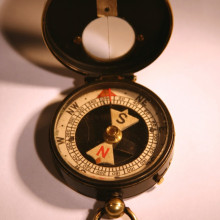
What does a compass do in space?
This basically depends where you are in space.
You may have played with a magnet when you were a kid with some iron filings on a piece of paper.
You'll have seen something that looks very much like the Earth's magnetic field produced by a magnet. From a magnet it comes out of the North Pole and curves round in two big ovals and comes back upwards at the South Pole.
We on Earth can't see that field and so when we're on the ground it's going from the South Pole to the North Pole and so the compass points north. If you were right at the North Pole it would actually point straight downwards and if you were at the south pole it would point straight upwards.
Now if you were out in space you would have the same thing. So if you were above the equator it would essentially be pointing to the north. And if you were above the Poles it would be pointing straight up or down.
The farther away you go, the weaker it will get so that eventually the sun's magnetic field will overwhelm it.
So if you were to fly around the world in a geosychronous way so that you were parallel to the equator and going round at the same rate as the Earth, it should still point north-south. But if you were to do an orbit Pole-Pole, like some of the weather satellites do, would it get confused as it went over the North Pole pointing straight down at the North Pole and rotating over and over its head as you go round.
Spaceships mostly they get their direction by looking at the stars. The North Star is always in the same direction so you look at where it is and you know which direction you're pointing in...
How do spiders spring webs across gaps?
Spiders produce a very light and floaty piece of silk from their spinneretts and just wave it out in the breeze. the wind will carry it away and if it actually sticks on to something a bit further away it can start building its web. It's all a bit chancy really, it's not a determined thing. Once that first little thin line has stuck on they'll climb along it and reinforce that first strut. Then they actually use their own bodies and footsteps to measure along and count back to the middle of it to get to the central point. Then they drop a sort of plumb line using themselves as the weight. They'll go down like an absailer down a cliff. They absail down that line to make a Y-shape and that is the scaffolding they'll fill in with different patterns.
Do daylight replacement boxes work?
There's lots of research on light boxes that really do work. Lots of people have Seasonal Affective Disorder. It's a real entity, we think it has a genetic basis. This is where people feel the urge to want to hibernate as soon as you go into Winter. As soon as the days start to get shorter, you don't get enough sun exposure. Or if you have to work nights, it can make you feel really quite nasty and quite depressed. For people who have this it can be quite disabling. So scientists have found that if you get a light box which gives you lots and lots of light in the morning (morning seems to be quite important) it seems to make people feel better. What's the physiological basis for it? Well, you have a body clock in the part of the brain called the suprachiasmatic nucleus in the hypothalamus. It's got about five thousand nerve cells that work like a genetic domino effect. One gene turns on a second gene which turns on a third gene and that turns on a fourth gene and that turns off the first gene again and the whole thing goes round in a circle. That's how it keeps time. It needs to be able to reset itself because if you go abroad on an aeroplane you get jetlagged for a little while before it resets. Recently, in the last four or five years, scientists have found there's a population of nerve cells in your eyes which see light which is at the blue end of the spectrum and they don't actually show your brain what they're seeing. They just tell your body clock what they're seeing. They tell the body clock when it's bright and when it's dark and by doing that they can reset your body clock and keep it in time. By shining this extra light, scientists think that's how you can rescue your body clock if you need to.
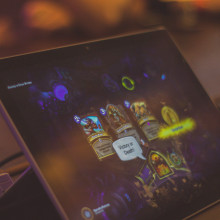
34:38 - Machinima
Machinima
with Chris Vallance
Now we have a new feature on the Naked Scientists each month with the help of Chris Vallance. We'll be taking a look at exciting new developments in the world of technology. This month he joins us to talk about the emerging world of machinima. This is where people use computer games to make movies of their own. They use design features built into the game to edit the scenery and use characters to tell a story of their own. They record this and distribute it over the internet. It sounds really weird and whacky but is actually a big business!
Red vs Blue clip - "Yes, everything is coming together as planned and these fools still have no idea. Once the young one gets his sword there will be no stopping us. Mwahahahahahaaa..."
Chris Vallance - What we just heard is a little clip of 'machinima'. Now, the word itself is a contraction of machine-cinema which tells you what it's all about. If you think about puppetry, well, these are films made. Instead of using physical puppets what you use are the characters in computer games. So, instead of picking up big bird or whatever the puppet of choice is, groucho, you go and turn on your Xbox or Playstation and use the characters in the game. Now what we heard there was a clip from one of the best-known machinima films, it's Red vs. Blue, it's based on the game Halo. It has become incredibly popular as many of these games have. And we've started to see them influence the mainstream. We're starting to see film-makers and advertisers pick up on this stuff as well which is why this weekend at De Montfort University, as the programme is going out, Europe's first festival of machinima bringing together filmmakers and people interested in this technology from all over Europe. I spoke to Professor Andre Hugill who is director of the Institute of Creative Technologies at De Montfort University. I asked him why machinima wasn't just an updated form of puppetry or physical theatre.
Andre Hugill - It's got elements of both of those and it's got elements of animation and cinema. What's unique is that it's user-generated content. It's empowering or enabling people to create original work fairly easily and they've got quite a range of resources available to them such as the ability to use camera angles, render buildings at any time of day or night with ease; create virtual environments and so on. I thin kit offers up a portfolio of possibilities.
Chris - So Andrew Hugill seems pretty convinced as to its worth but to be honest, Chris it sounds a little geeky or anorak-y. Do you think this is really going to catch on and be popular?
Chris Vallance - Well I think the examples there from advertising are perhaps the clearest. There are starting to emerge machinima-type commercials. In the States, recently aired during the football games, a Toyota commercial but was based on World of Warcraft. We have World of Warcraft characters and one of them suddenly pops up with a brand new Toyota truck and he meets the boss baddy at the end with his amazing magic pick-up. That kind of thing is definitely becoming mainstream. Now what's different about machinima is that it's actually live. The characters aren't manipulated and it's filmed without animation or careful step-by-step processes. It's much more like puppetry in that sense.
Chris - Do you actually see a convergence between what's happening in the gaming world then and the film world? Is this an attempt to maximise the commercial potential because you can get one feeding off the other?
Chris Vallance - If we go back to Red vs. Blue we've just had the new version of Halo out to much excitement in the gaming world. Obviously Red vs. Blue is based on Halo so how does the fact that there's a new version of the game affect the films? Well, that's a question I put to Jason Saldaña of Rooster Teeth, the company that produced Red vs. Blue.
Jason Saldaña - It's good. It makes us figure out ways to do it, it's fun to do and we also have fun playing the game. With Halo 3, I haven't stopped playing it since it came out and the same can be said for all of the guys that we work with.
Chris Vallance - And is this a full-time job for you now?
Jason Saldaña - Yes, it is.
Chris Vallance - How many people do you know of who make their living making machinima?
Jason Saldaña - Probably just the six of us.
Chris Vallance - But it must be pretty fun on mortgage applications, I imagine.
Jason Saldaña - Yeah! Trying to explain to people what I do...today I went to the dentists and they asked me what I did for work and it took me, like, 20 minutes to tell them. You know, it can bee complicated.
Chris Vallance - So you heard from Jason there, well he's actually making a living out of machinima. Okay, there are only a few people in the world who can claim that but that does suggest that it's starting to creep its way into the commercial sphere.
Chris - So what do people think of the potential for this kind of technology? There must be manifold spin-offs that you could do with this kind of thing.
Chris Vallance - Well, there are. I don't know how much of an 80s kid you were but do you remember the Human League, do you remember Heaven 17? Well, if you do you'll know who Martin Ware is. He was a member of all those bands. He's now part of a group called the illustrious company working with 3D soundscapes. I spoke to Martin and asked him how he saw the future of machinima developing.
Martin Ware - Well, I'm very interested in this new form of narrative. All the time, the barriers between the visual and the real are becoming broken down and I think Duran Duran have already done a full-scale concert in second life. That's not quite the same as machinima but it is related in a sense. For instance, the Gorillaz is an animated version of the band. Only a sort of art-conceit in a way. In my career as a musician and producer I've always been interested in things that relate to paint in the old still perspective of conceptualising stuff like mini-symphonies in four minutes. I think this is potentially the 21st century version of that from a musical point of view.
Chris Vallance - So I think that's quite a nice idea, the idea of a live performance, both of music and of a virtual video, if you like: produced in a machinima style way. Perhaps when Mick Jagger gets that little bit too creaky to finally make his way onto the stage he'll consider replacing himself with a character from Halo 3.
Chris - Well that sounds pretty good!. The Rolling Stones could carry on for another five thousand years. Thank you very much Chris for joining us this month to bring us up to speed on the art of machinima, which apart from being hard to understand is also impossible to say, We look forward to joining you again next month for another update on what's hot from the world of technology.
Chris Vallance - Look forward to it.

Why do chickens lay all year round?
Well, it's actually all to do with selective breeding over thousands of years...
Originally, if you get very old breeds of chicken, they are seasonal. Over each generation, people have been picking the chickens which lay the most eggs and trying to breed those chickens. And so, after generation after generation, the period which they lay eggs for is longer and longer and longer until, I'm not sure, probably the last 200 years, they got to the point where they had chickens which would lay eggs all year round.
So, now, chickens will lay eggs all year round. Naked Scientist Dave Ansell used to keep chickens when he was growing up , and noticed that they would lay a lot more in the Spring than in the rest of the year. In the Spring you'd get 2 or 3 times more eggs than you would, say, in the Winter.
With regards bloodspots, lots of people discard eggs that have blood spots in them because they think they've been fertilised. But there's more than one reason why you can have a bloodspot in an egg. As the egg is being formed in the oviduct, which is the part of the chicken which makes the egg, sometimes you can get a tear in the tissue or a leak from a blood vessel. This squirts a little bit of the chicken's blood into the egg. It's not harmful and doesn't mean the egg's been fertilised, it's just a bit of blood. So that's why you have bloodspots.
How much would the sea rise if we stopped storing water in our houses?
Assuming everyone was storing maybe a cubic metre of water, (although some people have very big swimming pools most people maybe only have a little tank of water in the loft between four or five people). So with ten billion people we'd have 10,000 billion litres of water stored. If you work out the area of the Earth it comes out at about 100,000 billion square metres so maybe sea level would rise by about a millimetre.The calculation is that every twenty thousand years or so enough water arrives from outer space to raise the level of the oceans about an inch. So, it's miniscule against that.
Would an alarm clock attached to a light work well?
Getting higher levels of light in the morning would certainly help to beat Seasonal Affective Disorder. There was also an alarm clock made by researchers in America which was teathered to your brainwave patterns. When you are dreaming and at certain points during the night you tend to have REM (rapid eye movements), this means your brain is much more active than when it's in deep sleep. If you wake someone up when the brain's much more active then they feel much better and come-to much quicker than if you wake them up when they're in a deep sleep. So with this clock which you set the ideal time to wake up, and then it follows your sleep pattern and wakes you up based on you brain activity as close to your ideal time as it can.

45:25 - Avian Heartbeat count?
Avian Heartbeat count?
We put this question to Neil Forbes, a specialist in bird medicine and the president of the European College of Avian Medicine & Surgery, based at Great Western Exotic Vets in Swindon.
A little bit of explanation. The questioner suggests that his bird's heartrate is 10 x his own and I think that, as in many of these cases, some of these figures are wrong. The resting heartrate of a macaw is published to be 127, rising to 350 when being restrained or upset or in flight. And the recommended lifespan of a macaw is 35-50 years as opposed to the 80 years which is suggested. Now taking those figures, that would work out with a heartbeat of 4.3-6.2 x 10^9 so, in fact, far less than the 1.5 trillion suggested. In reality I think the honest answer is that actually birds have less heartbeats than mammals and that isn't a surprise at all. The metabolic rate of a bird is significantly faster than a mammal. Rather similar to a car engine running a bit faster than another car and as such you would expect them to run out a bit sooner than a mammal, rather than a bit later.

Why do Jack Russell dogs sometimes run on three legs with a hind leg lifted?
This one has stumped the Naked Scientists team - we really don't know! Do you have any idea why this may be? If so, let us know!
Where is the safest place in a wood to run in a thunderstorm?
Well, you might think that standing under a tree is a really good idea because then the tree will get hit by lightning rather than you because it's a much better path than you are. The problem is that sap tends to heat up, turns to steam and then explodes, so you get bits of tree flying off and they can hit you and do more damage than possibly even by being hit by lightning itself. Also the tree is behaving as a wonderful lightning conductor and this is raising the the electrical potential of the ground around the tree. Animals like cows and sometimes horses are found dead in fields because the electricity flows over the ground. It's easier for the electricity to go up the cow's front legs, along its body and down its back legs, killing it in the process, than it is to go across the ground. At least some of the electricity does. So you could still get taken down by electricity spreading away across the forest floor.
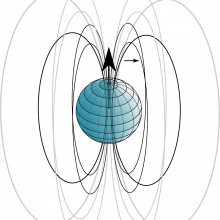
How long will the earths magnetic field dissappear for?
The Earth's magnetic field does seem to flip every few hundred thousand years and we're overdue for one at the moment. A few years ago they thought this would take hundreds of thousand of years for it to flip slowly. But recent evidence suggests that it'll maybe flip over faster. In the process of it flipping over it doesn't tend to flip over evenly. What tends to happen is the North Pole gets weaker and weaker and sometimes you get two, three or four other North Poles around the Earth in different places that move around quite fast. Eventually it'll stabilise again the other way around. maybe after 20-30 years.
Is it just humans that get runny noses?
No, we're not. Lots of creatures do have sticky noses and it's all about protecting yourself from those things you might be breathing in. Basically it's a layer of stickiness to catch dust and, more importantly, viruses that might invade your delicate mucous membranes. Things get breathed in and whirled around in your nose like in a miniature dyson vacuum cleaner, and then they get flung to the sides where you've got these sticky walls. Then you blow your nose and get rid of it, or swallow it so it gets broken down in your stomach.
- Previous Particle Physics Show
- Next Beer & Brewing
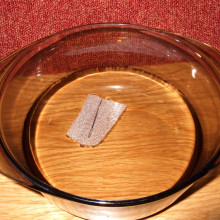










Comments
Add a comment